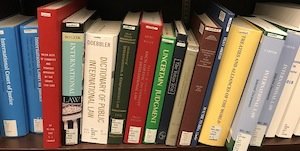Another must read from SLAW for those of you who remember that word collection and not having what you want for the firm decided for you by you know who and you know who.
It was a slow death. I should have seen it coming. First, the reference collection was right across from the reference desk – visible, in plain sight, and easy to get to. There were all these reference tools right there, in physical form. And then we weeded the reference collection. Moved some books to the regular stacks, and the remaining collection away into the main reading room area, so it took multiple, intentional steps to consult the books therein. And so it came to pass. The collection gathered dust as we forgot them or found other ways to obtain the information they contained. And then we weeded some more. We moved more books from the reference collection to the open stacks, to storage areas, and moved the remaining reference collection further away from the reference desk into the nether parts of the reading room. Small. Invisible. Out of sight. Out of mind. Dead. Well, essentially, mostly dead. *Record scratch* *Freeze frame* How did we get here?
Those were the days. When print looseleaf services reigned. And when people called to ask for definitions of words, you could find it in a dictionary nearby. And the encyclopedias could help you get started on helping a patron (we didn’t call them users or customers or clients back then). And with ready reference, you could just reach back while on the phone, pull a volume, and help a patron.
Those days are gone. When looseleafs became available online, there was joy throughout the land (although I enjoyed filing looseleaf services back in the day, there were serious problems with that format that the e-format addressed). With the rise of the Internet, increase in web content, web search engines such as Google, and digitization or online versions of key reference tools, the days of the physical reference collection were numbered.
For instance, if we look at my area of specialty, foreign, comparative, and international law (FCIL) librarianship, many of the key FCIL reference works have been digitized or are now e-only. In my 2000 article on “Gaps in International Legal Literature”, I wrote that researchers preferred to access legal information in electronic format, but most of the key tools only existed in print format back then. All of them are online now with the most recent digitization being the International Encyclopedia of Comparative Law (Brill, 2018). While there are some downsides (some of the tools have been digitized, but not updated), they are now available online.
So, what did we gain with e-access to reference collections? Ease of access from anywhere to legal information with the ability to download and share documents and speed up research, to get to full texts online quickly. No barriers.
What did we lose? The physical reference collection was curated over time. It was a collective project to gather in one place the best tools for the librarian to help the patron and for the patron to access for their research. It was institutional memory and passing on the wisdom of bibliographers and reference librarians over the ages to those that came after.
For me, the reference collection was my predecessor, Adolf Spr?džs, still teaching me as a young FCIL librarian about the important foreign and international legal reference tools, so when I referred a patron to a tool he had chosen to put there, I knew it was the best one. The reference collection was I, following in his footsteps, putting in it the best tools I’d learned about from my own assessment and from other FCIL specialists and scholars. There’s something about browsing the physical reference collection that brings forth its special nature and the careful stewardship in its creation.
But the physical reference collection had potential barriers for researchers. As a special collection, the books therein did not circulate (building use only). They were also removed from the regular collection, so required extra steps to access. They also sometimes required reference librarian intervention and assistance for patrons to use. They also contained dead or dying, less preferred formats such as print looseleaf services, research guides, bibliographies, catalogs, indexes, digests, dictionaries, thesauri, encyclopedias, directories, biographies, books of quotations.
A curated collection dispersed into the regular bookstacks or available online reduces some of those potential barriers. A no longer dedicated, “fenced in” physical reference collection means that users can locate key tools for their research in the regular books stacks along with other works, and borrow them, take them home if needed. They could discover the tools like they do other works, via the library catalog, word of mouth, and serendipitously.
But the indicia of specialness are gone. And, if information about the key tools is not being passed on to the patron, the researcher, via a physical, reference collection location, how will they know these reference sources exist? How will they find out about the best reference tools?
Pour one out for the physical reference collection. It served us well.
Long live free, open stacks, and online reference resources. May they meet the needs of our users today.
Source: http://www.slaw.ca/2018/11/02/the-death-of-the-reference-collection/




